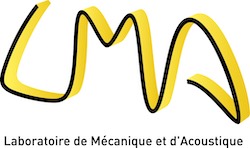Ce travail a été réalisé en collaboration avec Anthony Giacoma, David Dureisseix et Michel Rochette.
Industrial complex problems involving large contact zones may lead to prohibitive time of computations. Unfortunately, classic incremental solvers (e.g. Newton-Raphson) for contact problems could defeat the deployment of model reduction techniques well-known for their efficiency to reduce time of computing [1] . We propose to tackle the contact problem with the non-linear iterative LATIN (Large Time Increment) solver [2]. Then, a non-incremental time-space approach is adopted to solve the problem allowing the use of time- space model reduction technique. From a posteriori analyses using SVD (Singular Value Decomposition) of contact problems solutions, we exemplify the multiscale content of time-space reduced basis. Each of this basis vectors depicts a particular scale of the solution of the problem emphasizing the scale separability of contact problems. Moreover, depending on the complexity of the problem, its solution can be compressed into a small number of vectors as in [3]. We propose to take advantage of these scale separability by making analogies with multigrid solvers and namely the non-linear FAS (Full Approximation Scheme) multigrid solver [4,5]. Particular iterative solvers (called smoothers : PCG, GS ...) are able to damp rapidly the high-frequency components of the error through iterations whereas low-frequency components are slowly captured. Thus, coarser grids are used in order to correct low-frequency components. Similarly, we propose to consider as coarse grids a representation of iterated solutions over the first modes of the reduced basis (containing large scale information). The smoother is the non-linear LATIN solver and the overall strategy consists in a combination between the FAS multigrid solver and the LATIN method. Such a method increases convergence rate (in comparison to the LATIN method) and provides a well-suited approach for the parametric study framework.
References
[1] Kerfriden P, Gosselet P, Adhikari S, Bordas S. Bridging proper orthogonal decomposition methods and augmented Newton-Krylov algorithms : An adaptive model order reduction for highly nonlinear mechanical problems. Computer Methods in Applied Mechanics and Engineering, 2011.[2] P. Ladevèze. Nonlinear Computational Structural Methods : New Approaches and Non-Incremental Methods of Calculation. Springer-Verlag New York Inc., 1999.
[3] F. Galland, A. Gravouil, E. Malvesin, M. Rochette. A global model reduction approach for 3D fatigue crack growth with confined plasticity. Computer Methods in Applied Mechanics and Engineering, 2011.
[4] CH. Venner CH, AA. Lubrecht. Multilevel Methods in Lubrication. Elsevier, 2000.
[5] F. Lebon, M. Raous, I. Rosu, Multigrid Methods for Unilateral Contact Problems with Friction, IUTAM Symposium on Computational Methods in Contact Mechanics, Volume 3, pp 1-16, 2007.


